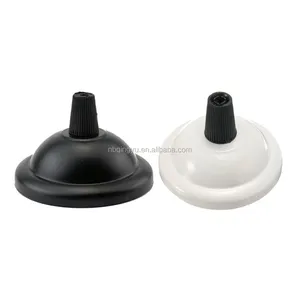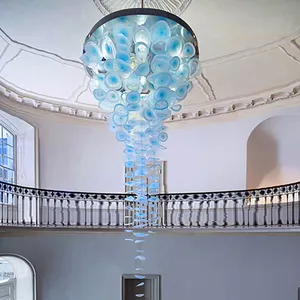Introduction
Lighting is a crucial element in defining the mood and functionality of a space. Pendant lights, known for their unique design and versatility, have become a popular choice for many. This guide aims to simplify the process of choosing the right pendant light parts, offering insights into the anatomy of pendant lights, the different types of parts, and how to select the right ones. It also provides practical tips on installation, maintenance, and harmonizing your lighting with your space's aesthetic.
Understanding Pendant Lighting
A pendant light is a distinctive light fixture that hangs from the ceiling on a rod, chain, or sometimes, multiple chains. Unlike a chandelier that incorporates multiple bulbs into a single fixture, a pendant light typically has only one bulb. Pendant lights can be installed almost anywhere an outlet is available, making them a versatile lighting option for various spaces.
The Basics of Pendant Light Parts
The basic anatomy of a pendant light includes various parts, each with a specific function. These components can be cable suspended, brass bar suspended, or chain suspended. The lamp holder and ceiling rose will vary depending on the suspension method. Understanding these parts is crucial for building or repairing your own lighting design.
Types of Pendant Light Parts
Pendant light parts are essential for creating a unique lighting design. These components include the lamp holder and ceiling rose, which vary depending on the suspension method - cable, brass bar, or chain. The hardware options also differ between bare bulb style pendants and shade pendants. Understanding these components and their functionality is crucial when creating your own pendant light or restoring an antique piece.
Choosing the Right Bulb
Choosing the right bulb for your pendant light is crucial. Bulbs are identified by a letter indicating the shape or type, and a number for the approximate diameter in eighths of an inch. Each type has its unique features and applications, making it suitable for different lighting needs.
Selecting the Perfect Shade
Pendant lights come with different shade materials, each influencing the light emission differently. The type of shade you choose for your pendant light plays a significant role in the overall lighting effect in your space.
Picking the Ideal Pendant Light Base
The base of a pendant light is a key component that holds the bulb and connects the fixture to the power source. The choice of base can affect the style, functionality, and safety of your pendant light.
Understanding the Importance of Cords and Chains
Cords and chains are integral parts of pendant lights. They not only serve a functional purpose but also add to the aesthetic appeal of the light fixture. This design allows pendant lighting to be installed almost anywhere an outlet is available, without the hassle and expense of adding wiring in the ceiling.
How to Match Pendant Light Parts with Your Space
When matching pendant light parts with your space, it's crucial to consider harmony and balance. Mixing brands, colors, and textures can add interest and character to your space. Your lighting plan should enhance your space's aesthetic without overpowering it.
Considering the Room's Function
The function of the room significantly influences the choice of pendant light parts. For instance, in a living room where people gather for long periods, ambient lighting that bounces off the ceiling creates a sense of brightness and avoids shadows. Similarly, in a kitchen, task lighting is essential for counters and sinks where most work takes place.
Harmonizing with the Room's Aesthetic
Harmonizing your pendant light parts with your room's aesthetic is crucial. Using fixtures with the same or similar shapes, colors, materials, or styles can bring harmony to the space. Varying the brands, colors, and sizes can create interest, scale, and character in a space. Your goal is to create a custom look and feel.
Balancing Size and Scale
Choosing the right size and scale for your pendant light is crucial in achieving a balanced and harmonious look in your kitchen. The size of the pendant light should be based on the size of your kitchen island. The pendant light should not overpower your island but rather complement it, providing both functional and aesthetic value.
Factoring in Light Intensity and Color
When choosing pendant light parts, understanding Kelvin temperature (K) is crucial as it influences the look and feel of your space. The color temperature of your bulb can drastically change the ambiance. It's important to select a bulb with a color temperature that suits your desired aesthetic and functional needs.
Installation Tips for Pendant Lights
Before installing a pendant light, ensure the power is off at your electrical panel. Use a voltage tester to confirm no electricity is flowing through the wires. If your house was built before 1970, you might not have a ground wire. Use a piece of coat hanger wire, bent in an 'S' shape and hooked onto the mounting bracket, to support the fixture while you connect the wires.
Safety Precautions
Installing pendant lights involves dealing with electricity, which is best left to trained, experienced, and licensed professionals. Always ensure the hanging distance is correct to avoid any mishaps.
Professional vs. DIY Installation
Installing a pendant light can be a DIY project, even for beginners. However, if you're not comfortable with electrical work, it's recommended to hire a professional to ensure safety and proper installation.
Maintenance and Care for Pendant Lights
Maintaining pendant lights involves regular cleaning to ensure optimal brightness. Over time, dust and grime can make bulbs appear dimmer. Cleaning your pendant lights will ensure they emit the right amount of lumens. For cleaning, turn off the power to avoid any risk of electric shock.
Cleaning Tips
Cleaning pendant lights requires care. After turning off the power, wipe down the bulbs gently with a dry, soft cloth. For the globes, cables, and extension rods, use a damp cloth. Avoid applying force to a tight bulb; instead, use a duct tape loop for easier removal. Remember, never put shades in a dishwasher or washing machine as it may damage them.
Regular Check-ups and Replacements
Regular check-ups and replacements are crucial for maintaining the brilliance of your pendant lights. If you notice your bulbs are heavily dirty, they may require replacing. Always ensure the power to your lights is off or they’re unplugged before starting any cleaning or replacement process.
Conclusion
Choosing the right pendant light parts can significantly enhance the aesthetic and functionality of your space. Understanding the different components, their roles, and how they interact is crucial. Consideration of the room's function, aesthetic, size, and light intensity can help you make the right choices. While installation can be a DIY project, professional help is recommended for those uncomfortable with electrical work. Regular maintenance and care, including cleaning and replacements, ensure your pendant lights continue to shine brightly. With this guide, you are well-equipped to revamp your space with the perfect pendant light.





























 浙公网安备 33010002000092号
浙公网安备 33010002000092号 浙B2-20120091-4
浙B2-20120091-4